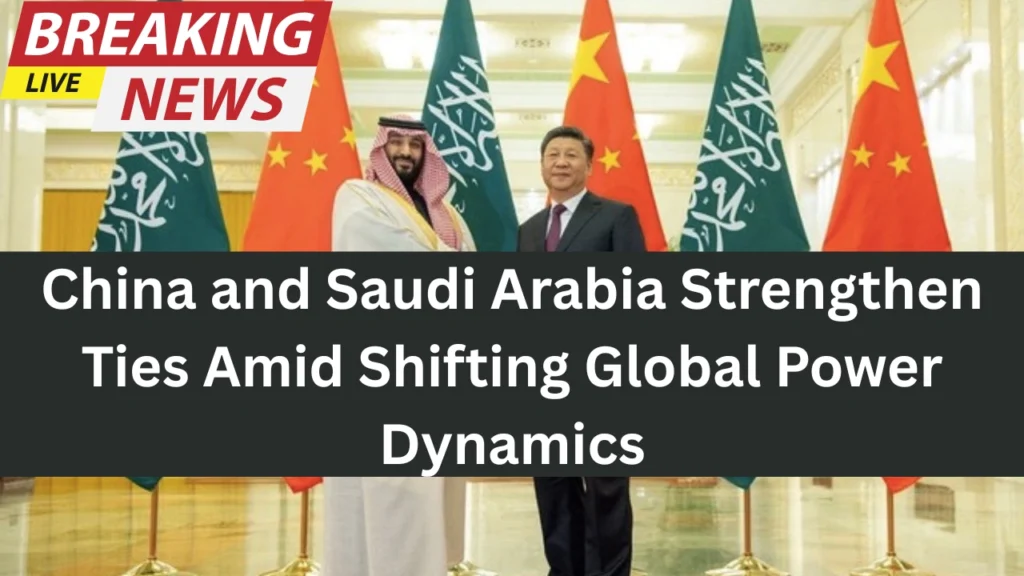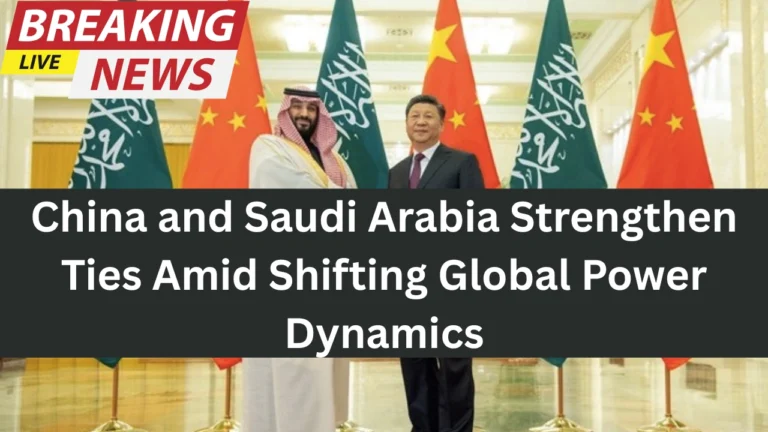In an era marked by rapidly evolving global alliances, the burgeoning relationship between China and Saudi Arabia has emerged as a significant development in the geopolitics of the Middle East and beyond. With a firm foundation built on energy cooperation, economic investments, and shared developmental visions, Beijing and Riyadh have steadily deepened their strategic partnership a move that is reshaping the balance of power in the Middle East and North Africa (MENA) region.

The most compelling symbol of this evolving relationship was seen in March 2023, when Iran and Saudi Arabia resumed diplomatic ties after a seven-year hiatus, thanks to a landmark deal brokered by China. The agreement not only highlighted China’s growing political clout in West Asia but also signaled a new diplomatic posture for Beijing one that goes beyond economics and delves into security and regional stability.
Xi Jinping, President of China:
— محمد بن سلمان بن عبد العزيز (Informal) (@HRHMBNSALMAAN) February 14, 2025
"Mohammed bin Salman builds bridges of cooperation between Saudi Arabia and China, and leads a future vision for common development" pic.twitter.com/GSZ8WNZkdi
A Shift from the West to the East
For decades, Saudi Arabia was a pillar of U.S. foreign policy in the Gulf region. However, recent years have witnessed a perceived withdrawal of American influence and a more assertive China stepping into the vacuum. China’s diplomatic mediation between Riyadh and Tehran sent a clear message to the international community: Beijing is no longer content with being a passive economic player it seeks to become a geopolitical force as well.
The reconciliation between Iran and Saudi Arabia, facilitated in Beijing in April 2023, also demonstrates China’s balancing act. While it maintains a close partnership with Iran especially through a 25-year cooperation agreement it has simultaneously cultivated robust ties with Saudi Arabia, demonstrating its capacity to engage with regional rivals in pursuit of broader strategic interests.
Energy Diplomacy as the Cornerstone
At the heart of the China-Saudi relationship lies a mutual dependence on energy. China is the largest importer of Saudi oil, and Saudi Arabia is China’s top crude supplier, accounting for over 17% of its total oil imports. As China’s industrial and urban sectors continue to expand, its need for stable, long-term energy sources has made Saudi Arabia a vital strategic partner.
During President Xi Jinping’s state visit to Riyadh in December 2022, the two nations signed a comprehensive strategic partnership agreement, underscoring their commitment to enhancing cooperation in energy security, refining, clean energy, and joint energy investments across third-party markets.
Saudi Arabia, in return, views China as a reliable customer and investor, especially as it seeks to diversify its economy and reduce its reliance on oil exports. The kingdom has increasingly turned to Asian markets, and China, with its insatiable energy appetite, is at the forefront of that pivot.
Economic Integration Through Vision 2030 and the BRI
Beyond energy, China and Saudi Arabia are aligning their respective development visions: Beijing’s Belt and Road Initiative (BRI) and Riyadh’s Vision 2030. This alignment reflects both countries’ shared priorities in infrastructure development, digital transformation, and industrial diversification.
Vision 2030, spearheaded by Crown Prince Mohammed bin Salman, aims to transform Saudi Arabia into a global investment hub, reducing its dependence on hydrocarbons. Key sectors identified include renewable energy, AI, biotechnology, tourism, and smart cities.
China, through the BRI, has pledged massive infrastructure investments across Asia, Africa, and the Middle East. Saudi Arabia’s geographic location and its ambition to become a logistics and connectivity hub make it a natural partner for the BRI.
Several joint ventures and MoUs were signed during Xi’s 2022 visit, including cooperation in green hydrogen projects, digital economy development, and smart infrastructure. Chinese tech giants such as Huawei have already played a role in building 5G infrastructure in the kingdom, despite objections from Washington.
Strategic and Political Significance
The strategic calculus behind the China-Saudi partnership goes far beyond trade and development. As U.S.-Saudi relations face turbulence stemming from issues like human rights, oil production policies, and regional conflicts Saudi Arabia is seeking to diversify its global alliances.
China’s principle of non-interference in domestic affairs, along with its no-strings-attached investment philosophy, makes it an appealing partner for Riyadh. In return, China gains strategic depth in a region long dominated by the West, access to critical energy corridors, and a potential leverage point in its broader rivalry with the United States.
Moreover, China’s growing influence in the region could help reshape regional security architectures, potentially providing alternatives to U.S.-led frameworks such as CENTCOM or traditional Western alliances.
Mediation and Multipolarity
China’s role in mediating between Iran and Saudi Arabia marked a watershed moment in its foreign policy. For years, Beijing had focused on economic diplomacy. But this geopolitical intervention suggests that China is now ready to take on greater responsibility in regional conflict resolution.
With the U.S. often seen as taking sides especially in conflicts involving Israel and Iran China positions itself as a neutral, stabilizing force. This neutrality allows Beijing to navigate complex regional rivalries while enhancing its credibility as a global power in a multipolar world.
This mediation aligns with China’s broader narrative of multipolarity, challenging the notion of a U.S.-led unipolar world and promoting regional self-determination without Western imposition.
What’s at Stake for Saudi Arabia?
For Riyadh, the partnership with China is not about replacing one global patron with another. Instead, it’s about crafting a multi-vector foreign policy that maximizes national interest and economic diversification. Saudi Arabia’s growing ties with China do not necessarily imply an abandonment of the U.S. alliance but rather, a recalibration in favor of strategic autonomy.
In doing so, Saudi Arabia is signaling that it is open to new alliances, driven by shared economic goals, mutual respect for sovereignty, and pragmatic diplomacy.
Looking Ahead
The strengthening of China-Saudi Arabia relations is not merely a regional development it is a signal of global transformation. As American influence in the Middle East recalibrates, China is steadily building its footprint through energy, infrastructure, diplomacy, and now, geopolitics.
If the current trajectory holds, the China-Saudi partnership could redefine regional alignments, challenge the status quo of Western dominance, and contribute to the emergence of a new geopolitical equilibrium one rooted in economic pragmatism and strategic multipolarity.

